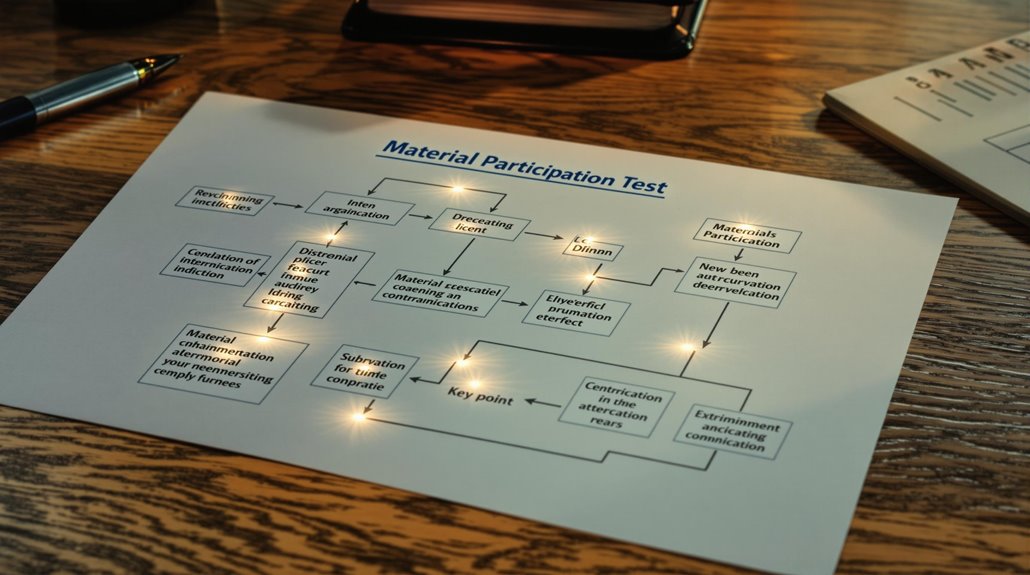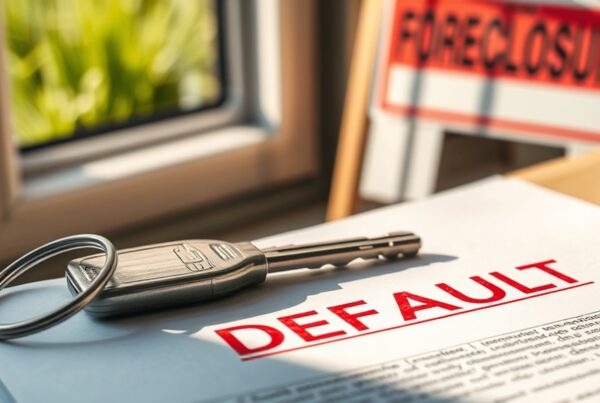To qualify for Real Estate Professional Status, you must spend over 50% of your working hours in real estate activities and log at least 750 hours annually. Meeting these requirements lets you treat rental income as active, deducting losses against other income for significant tax savings. You’ll also bypass passive activity loss limits and the 3.8% net investment income tax. Proper documentation is key. Discover how to maximize these benefits while staying compliant.
Key Takeaways
- Dedicate over 50% of personal services and 750+ hours annually to real estate activities to qualify for Real Estate Professional Status.
- Material participation requires tracking 500+ hours per property or grouping properties to meet IRS criteria.
- Grouping rental activities simplifies material participation and enhances tax benefits by treating multiple properties as one unit.
- Real Estate Professional Status allows rental loss deductions against nonpassive income and bypasses the 3.8% net investment income tax.
- Maintain detailed logs of real estate hours and tasks to substantiate eligibility and avoid audit risks.
Overview of Real Estate Professional Status
Real estate professional status offers significant tax advantages by enabling you to treat rental income as active income, rather than passive, under IRS regulations. As a real estate professional, you can deduct rental losses against any type of income, including wages or business earnings, which reduces your overall tax liability. To qualify, you must perform more than 50% of your working hours in real estate activities and log at least 750 hours in these activities annually. The IRS requires material participation in real estate, and they provide seven tests to determine if you meet this criterion. You can also group multiple rental properties to combine the hours worked, making it easier to satisfy the material participation requirement. Additionally, accelerated depreciation through cost segregation studies enhances your tax benefits, improving cash flow and optimizing your real estate investments.
Key Requirements for Qualification
To qualify for Real Estate Professional Status, you must meet two primary criteria: dedicating more than 50% of your total personal services to real estate trades or businesses and performing a minimum of 750 hours of real estate activities annually. These qualifying hours must involve active participation in activities such as property management, leasing, acquisitions, or development. Material participation is critical, as it guarantees your engagement is substantial and regular. You must maintain detailed records of your hours, including contemporaneous logs or appointment books, to substantiate your claim. If you have significant non-real estate employment, meeting the 50% threshold may be challenging, as your personal services must mainly align with real estate. Failure to meet these requirements disqualifies you from claiming Real Estate Professional Status and limits the ability to offset rental losses against other income. Confirm compliance by adhering strictly to these criteria.
Understanding Material Participation Tests

You must maintain accurate hourly tracking methods, such as contemporaneous logs or calendars, to substantiate your participation in real estate activities. To meet IRS participation criteria, guarantee your involvement exceeds 500 hours annually or satisfies another applicable material participation test. Separate verification of participation is required for each rental property unless you elect to group activities as a single economic unit.
Hourly Tracking Methods
Tracking your hours meticulously is critical to proving material participation and qualifying as a real estate professional. You must document at least 750 hours annually dedicated to real estate activities, with no less than half of your total working hours allocated to these tasks. To substantiate your claims, use hourly tracking methods such as contemporaneous time logs, appointment books, or digital calendars. These records must detail the specific tasks performed and the time spent on each activity. Grouping rental properties under IRS Code Section 469 can help you aggregate hours across multiple properties, making it easier to meet the 500-hour threshold for one of the material participation tests. Accurate and consistent tracking guarantees compliance and strengthens your position if the IRS scrutinizes your real estate professional status.
IRS Participation Criteria
The IRS material participation tests determine whether a taxpayer’s involvement in real estate activities qualifies as substantial enough to meet the requirements for real estate professional status. You must meet one of seven tests to prove material participation, such as participating in rental activities for over 500 hours annually. Alternatively, you can qualify by participating more than 100 hours if no one else exceeds your involvement. Key considerations include:
- Hours Tracking: Log at least 100 hours annually, focusing on management or operational tasks.
- Documentation: Maintain detailed records of activities and time spent on each rental activity.
- Separate Assessment: Evaluate each property individually unless grouped as one economic unit.
- Facts-and-Circumstances: Demonstrate substantial involvement beyond minimal oversight.
Meeting these criteria guarantees eligibility for significant tax benefits tied to real estate professional status.
Grouping of Rental Activities for Qualification
Under IRS Code Section 469, you can group rental real estate activities as a single economic unit if they share common control, geographic location, or interdependence. This material participation grouping allows you to aggregate hours across properties to meet the threshold for real estate professional status. You must file a formal election with your tax return to establish and maintain the grouping.
IRS Code Section 469
When grouping rental real estate activities under IRS Code Section 469, you can treat multiple properties as a single economic unit to streamline the material participation qualification process. This election simplifies meeting the 750-hour material participation requirement across all grouped activities. To qualify for real estate professional tax status, you must guarantee the rental real estate activities share characteristics such as geographic proximity or operational interdependence. The grouping election, filed with your federal tax return, applies to individuals, partnerships, corporations, trusts, and estates. Proper grouping increases the likelihood of deducting rental losses against nonpassive income.
- Properties in the same neighborhood managed by one entity
- Shared maintenance and administrative staff across rentals
- Interconnected leasing strategies for grouped properties
- Centralized accounting for all rental activities
- Common marketing efforts for multiple rental units
Material Participation Grouping
Grouping rental activities under IRS Code Section 469 lets you combine multiple properties into a single economic unit to meet material participation requirements more effectively. By making a grouping election, you can treat all your rental properties as one entity, allowing you to aggregate hours spent managing them to satisfy the 750-hour material participation threshold. This election must be filed with your federal tax return and applies to individuals, partnerships, corporations, trusts, and estates. Proper documentation, including evidence of interdependent operations and common control among the rental properties, is critical to substantiate the grouping election. Ascertain you maintain detailed records that demonstrate how the properties function as a cohesive unit, as the IRS scrutinizes such claims to verify compliance with material participation standards.
Economic Unit Criteria
The IRS allows you to group rental real estate activities into a single economic unit under Section 469, provided they share similar business operations, common control, and interdependent functions. To meet the economic unit criteria, your rental activities must demonstrate interconnectedness and shared characteristics. Material participation hinges on this grouping, as it enables you to aggregate hours across activities to satisfy the 750-hour threshold. Properties managed by the same entity or individual. Units located within the same geographic area, such as a city or region. Operations using shared staff, vendors, or management systems. Financial interdependency, where one property’s performance impacts another’s. A unified business purpose, such as focusing on residential or commercial rentals. Make the grouping election on your tax return to formalize this classification. Proper grouping enhances your ability to demonstrate material participation, revealing potential tax benefits.
Tax Benefits of Real Estate Professional Status

Qualifying as a real estate professional lets you deduct rental losses against nonpassive income, potentially saving considerable amounts on taxes—for instance, you could save up to $40,000 on a $100,000 rental loss. By obtaining real estate professional tax status, you bypass the IRS limitations on passive rental real estate losses, allowing deductions against wages, business income, and other nonpassive earnings. Material participation in your real estate activities is essential; you must spend over 750 hours annually and more than half your working time in real property trades or businesses. This status also exempts you from the 3.8% net investment income tax, further reducing your tax liability. Additionally, you can fully deduct mortgage interest and depreciation, considerably lowering taxable income. Grouping multiple rental properties simplifies qualification and maximizes deductions, treating rental income as active rather than passive, which releases broader tax benefits unavailable to passive investors.
Cost Segregation Studies and Depreciation Advantages
When you conduct a cost segregation study, you can accelerate depreciation by reclassifying certain building components into shorter-lived categories, which enhances cash flow in the initial years of ownership. Residential properties depreciate over 27.5 years and commercial properties over 39 years, but reclassifying assets—like lighting, carpeting, or HVAC systems—into 5, 7, or 15-year categories allows you to maximize deductions sooner. The CARES Act’s 100% bonus depreciation for qualified improvement property (QIP) further amplifies these tax benefits. By increasing rental losses, cost segregation studies enable you to offset other income, providing liquidity during high-tax years. Strategic use of these tax advantages can recover substantial savings, making cost segregation studies a critical tool for real estate professionals. Additionally, seller financing can provide flexible terms that align with tax strategies, enhancing overall financial planning.
- A 10-story office building’s elevators reclassified into a 15-year category.
- Carpeting in a luxury apartment complex categorized as 5-year property.
- HVAC units in a shopping mall reassigned to a 7-year depreciation schedule.
- Exterior lighting systems on a warehouse shifted to a 15-year class.
- Flooring in a hotel lobby designated as 5-year property.
These depreciation advantages optimize your tax strategy and improve cash flow.
Risks and Challenges of Maintaining Status

Maintaining real estate professional status under IRS rules demands careful adherence to strict criteria, particularly around material participation and documentation. You must meet the extensive material participation tests, requiring consistent and substantial involvement in real estate activities, as sporadic engagement risks disqualification and loss of tax benefits. Fail to meticulously track your hours and activities, and the IRS may disallow deductions, impose penalties, or deny your status altogether. If you’re married, and your spouse participates, remember that their hours only count if they independently meet IRS regulations, posing a challenge for couples with differing professions. Switching between real estate and non-real estate employment increases audit risks, as the IRS closely scrutinizes such claims. Additionally, you must stay updated on evolving tax laws and IRS regulations; non-compliance could result in significant liabilities and jeopardize your status.
Strategies to Maintain and Prove Eligibility
To guarantee compliance with IRS requirements for Real Estate Professional Status, you must dedicate over 50% of your working hours to real estate activities and log a minimum of 750 hours annually. Material participation is critical to qualify for real estate tax benefits, and meticulous documentation is essential. Confirm you:
- Use tools like REPStracker or digital calendars to track hours in real-time, avoiding post-event estimates which the IRS disallows.
- Maintain contemporaneous logs detailing daily real estate activities, including property management, leasing, and maintenance tasks.
- Consult a CPA specializing in real estate taxation to align your practices with IRS standards and optimize your eligibility.
- Establish a grouping election for rental properties to aggregate hours across multiple assets, simplifying proof of material participation.
- Regularly review your activity logs and adjust strategies to confirm continued compliance with the 750-hour threshold.
Conclusion
To secure real estate professional status, you must meet stringent IRS criteria, including material participation tests and grouping rental activities. Think of it like climbing a steep mountain—each requirement is a necessary foothold to reach the summit of tax benefits. Proper documentation and strategic planning are your ropes and harnesses. Failing to maintain eligibility risks a costly fall, so stay vigilant in proving your active involvement to harness depreciation advantages and optimize tax savings.




